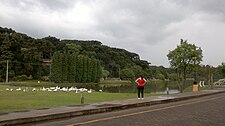São Francisco de Paula, Rio Grande do Sul


 Brazil
Brazil Rio Grande do Sul
Rio Grande do SulSão Francisco de Paula is a city in the Serra Gaúcha of the state of Rio Grande do Sul, Brazil. The municipality covers about 3,289.7 km2 (1,270.2 sq mi) and sits about 112 km (70 mi) from Porto Alegre. As of 2020, the city's population was estimated to be 21,801. The municipality was originally created on December 23, 1902.
The city is a tourist destination and is a link along two official scenic tourist routes: the Região das Hortênsias and the Rota Romântica.
The municipality contains the São Francisco de Paula National Forest, a 1,616 hectares (3,990 acres) sustainable use conservation area created in 1968.[3] It also contains part of the 6,655 hectares (16,440 acres) Tainhas State Park, created in 1975.[4]
Climate
São Francisco de Paula features an Oceanic climate (type Cfb), with humid, cool-to-warm summers and humid, cold winters. Snowfalls may occur during winter between July and August. It is the wettest place in Rio Grande do Sul State with more than 2,100 millimetres (83 in) of rain precipitation per year.
| Month | Jan | Feb | Mar | Apr | May | Jun | Jul | Aug | Sep | Oct | Nov | Dec | Year |
|---|---|---|---|---|---|---|---|---|---|---|---|---|---|
| Mean daily maximum °C (°F) | 24.9 (76.8) | 24.2 (75.6) | 23.0 (73.4) | 19.9 (67.8) | 17.6 (63.7) | 16.3 (61.3) | 16.3 (61.3) | 17.3 (63.1) | 18.1 (64.6) | 20.0 (68.0) | 22.0 (71.6) | 23.3 (73.9) | 20.2 (68.4) |
| Daily mean °C (°F) | 19.8 (67.6) | 19.4 (66.9) | 18.2 (64.8) | 15.2 (59.4) | 12.9 (55.2) | 11.7 (53.1) | 11.3 (52.3) | 12.3 (54.1) | 13.4 (56.1) | 15.0 (59.0) | 16.8 (62.2) | 18.0 (64.4) | 15.3 (59.5) |
| Mean daily minimum °C (°F) | 14.8 (58.6) | 14.7 (58.5) | 13.5 (56.3) | 10.5 (50.9) | 8.3 (46.9) | 7.1 (44.8) | 6.4 (43.5) | 7.4 (45.3) | 8.7 (47.7) | 10.1 (50.2) | 11.6 (52.9) | 12.7 (54.9) | 10.5 (50.9) |
| Average precipitation mm (inches) | 187.0 (7.36) | 182.0 (7.17) | 182.0 (7.17) | 169.0 (6.65) | 165.0 (6.50) | 191.0 (7.52) | 170.0 (6.69) | 170.0 (6.69) | 201.0 (7.91) | 188.0 (7.40) | 139.0 (5.47) | 166.0 (6.54) | 2,110 (83.07) |
| Source: Climate Data.[5] | |||||||||||||
Gallery
-
 RS-020 Highway in São Francisco de Paula
RS-020 Highway in São Francisco de Paula -
 São Francisco de Paula
São Francisco de Paula
References
- ^ IBGE 2020
- ^ "Archived copy" (PDF). United Nations Development Programme (UNDP). Archived from the original (PDF) on July 8, 2014. Retrieved August 1, 2013.
{{cite web}}: CS1 maint: archived copy as title (link) - ^ Unidade de Conservação: Floresta Nacional de São Francisco de Paula (in Portuguese), MMA: Ministério do Meio Ambiente, retrieved 2016-05-31
- ^ "Parque Estadual de Tainhas", cambaradosul.tur.br (in Portuguese), archived from the original on 2016-02-14, retrieved 2016-12-09
- ^ "Town Climate: São Francisco de Paula" (in Portuguese). Climate Data. Archived from the original on July 17, 2015. Retrieved October 13, 2014.
{{cite web}}: CS1 maint: bot: original URL status unknown (link)














